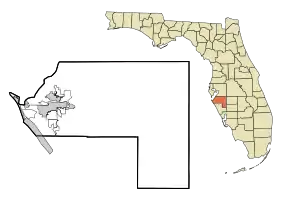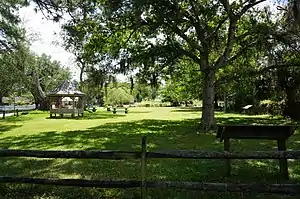Manatee Mineral Springs Park
Manatee Mineral Springs Park (formerly Indian Springs Park) is a neighborhood park located in Bradenton, Florida. The park is named after a natural spring at the location. The park is one of the region's oldest parks and will serve as a gateway to the city's Riverwalk eastern expansion. The park is a public–private partnership that is open to public use.
| Manatee Mineral Springs Park | |
|---|---|
| Indian Springs Park | |
 Historical marker located in the park | |
 Location in Manatee County | |
| Location | Bradenton, Florida |
| Coordinates | 27°29′51.41″N 82°32′57.04″W[1] |
| Area | 1.96 acres (0.0079 km2) |
| Created | January 1842 |
| Operated by | City of Bradenton |
| Open | Year round |
History

Over many centuries, people who traveled or hunted or settled along the nearby section of the Manatee River took water from the spring.[2]
The park was designated in 2018 as a site on the Underground Railroad Network to Freedom.[3] This recognizes that the spring was used by individuals who had escaped slavery and lived near the spring between the end of the 1700s and when Florida became a territory in 1821.[4] Angola was destroyed by a massive slave raid in early 1821; some escaped to the Florida interior or the Bahamas.[5]
Currently the park has picnic tables and a small gazebo. Interpretive signs tell the stories of the people who have used the spring over the centuries including pre-Columbian Indians, Spanish explorers, the freedom seekers of Angola, Manatee's first settlers, and soldiers during the Third Seminole war and Civil War.[6] The park adjoins the Curry Houses Historic District.[7] In January 2020, City of Bradenton funded excavations recovered evidence of several of those past landscapes [8]
A Florida State Historical Marker at the park commemorates the early Anglo-American settlement of Manatee that grew up around the spring. Three Spanish fisherman guided Josiah Gates, Manatee's first white settler, to this spot in late 1841. In 1842 Henry and Ellen Clark acquired the spring property and built the town's first trading post.
In 2006, the park's natural spring was designated a "Florida Natural Spring" by the Florida Geological Survey of Natural Springs.[1][9] The park's giant black bead tree growing next to the spring was put on the National Register of Big Trees in 2007.
References
- Schmidt, Walter; DEP (October 12, 2004). "Springs of Florida" (PDF). Florida Geological Survey Bulletin. 66: 365, 566. Retrieved April 16, 2018.
- "REFLECTIONS OF MANATEE, INC". REFLECTIONS OF MANATEE, INC. Retrieved May 7, 2019.
- "Visit Underground Railroad Locations - Underground Railroad (U.S. National Park Service)". nps.gov. Retrieved May 7, 2019.
- Baram 2012
- "Looking for Angola". Retrieved May 7, 2019.
- Baram 2014
- "CURRY HOUSES HISTORIC DISTRICT". REFLECTIONS OF MANATEE, INC. February 24, 2018. Retrieved May 7, 2019.
- https://www.bradenton.com/news/local/article239456678.html
- "Manatee Mineral Springs Park". City of Bradenton. Retrieved April 16, 2018.
- Baram, Uzi. "Cosmopolitan Meanings of Old Spanish Fields: Historical Archaeology of a Maroon Community in Southwest Florida" Historical Archaeology 46(1):108-122. 2012
- Baram, Uzi "Many Histories by the Manatee Mineral Spring" Time Sifters Archaeology Society Newsletter March 2014 http://files.ctctcdn.com/d1e1db8f001/28309dee-6a81-46f1-967f-d511065af014.pdf